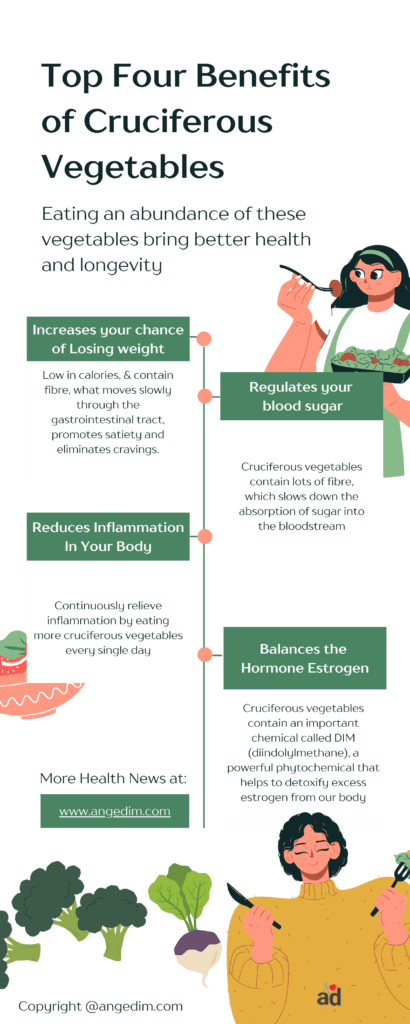Eating an abundance of these vegetables brings better health and longevity.
Cruciferous vegetables are not only nutrient dense and filled with a multitude of vitamins – they help to lower inflammation which is very important in today’s disease-riddled world.
These veggies are referred to as cruciferous because they are members of the mustard family. That name is signified as ‘cross bearing’ because the four rose petals resemble a cross. Cruciferous veggies come in all shapes, colours and sizes. Not only are they rich in phytonutrients and fibre and low in calories, but they also help to satisfy your appetite without having to eat a lot of them. It would be extremely hard to overeat these vegetables because they are so dense. You don’t need to eat a lot, either. About 2.5 cups per day of these veggies are more than sufficient. You could easily space these portions out during every meal. That also includes breakfast! How you might say, what about having an antioxidant-rich smoothie with berries and cruciferous veggies? To get the best cancer-fighting and health benefits from these marvellous vegetables, you must know which ones to eat and integrate as many of them as possible within your weekly meal planning. Chop them up a few days beforehand, and pile them up in a tray with herbs, spices and coconut oil. Bake to perfection, steam or use in soups.
Here is a complete list of the most popular list of cruciferous vegetables
- Cabbage
- Kale
- Broccoli
- Brussels sprouts
- Turnips
- Bok choy
- Watercress
- Collard greens
- Mustard Greens
- Arugula
- Cauliflower
Scientists don’t know why cruciferous vegetables are linked to the reduction of cancer in humans. However, studies have shown that the bioactive components in cruciferous veggies make them so beneficial in cancer-related processes in a few individuals. 
Here are some key benefits you will attain when regularly eating cruciferous vegetables
One: You regulate your blood sugar
Cruciferous vegetables contain lots of fibre, which slows down the absorption of sugar into the bloodstream. It’s the key factor preventing spikes and crashes that usually lead to consuming even more sugar-rich foods. One study in China discovered that eating a higher intake of cruciferous vegetables significantly decreased type two diabetes.
Two: Helps balance estrogen
You may wonder how something as simple as a veggie can help regulate estrogen. Researchers have discovered a direct link between cruciferous vegetables and estrogen. Cruciferous vegetables contain an important chemical called DIM (diindolylmethane), a powerful phytochemical that helps to detoxify excess estrogen from our bodies. Cruciferous vegetables are filled with a sulphur compound that helps to detoxify a sluggish liver. It also helps to eliminate bloating, gas, weight gain and constipation, to name a few.
Three: Help you lose weight
If you are currently finding it challenging to lose weight, adding more cruciferous vegetables is exactly what you need. These veggies are not only low in calories, but they also contain fibre, which moves slowly through the gastrointestinal tract. That itself promotes satiety and eliminates cravings. A study followed 525 women over 20 months. Each gram of fibre these women ate reduced their body weight by half a pound, leading to a 0.25 per cent drop in body weight. Adding cruciferous vegetables isn’t quite enough when it comes to weight loss. Ensure you eat less (or none at all) processed foods and more fruits and veggies, and also make exercise one of your primary ways to help reach your weight loss goals. Cruciferous vegetables play one part in the success of your diet goals.
Four: Reduce inflammation
We should all worry about inflammation since it’s a silent predictor of our future health. For example, it can make us more susceptible to heart disease, cancer and diabetes. One way to ensure you continuously relieve inflammation is to eat more cruciferous vegetables daily. One study published in the Journal of the Academy of Nutrition and Dietetics showed that higher consumption of cruciferous vegetables was associated with a 25 per cent reduction of inflammation markers amongst 1,005 women. Be sure to include other key anti-inflammatory foods such as blueberries, strawberries, beetroot and tart cherries.
Some side effects of eating cruciferous vegetables
Cruciferous vegetables are very beneficial, but they do cause some side effects. For example, some people experience a lot of gas or gastrointestinal distress. That’s why it’s recommended to increase your fibre intake slowly until your gut becomes accustomed to more fibre. There is also a bit of concern regarding your thyroid and cruciferous vegetables. If eaten raw, cruciferous vegetables release goitrogens in the intestines, increasing the need for iodine and damaging the thyroid glands. It takes a huge amount of veggies for this to happen, but ensure you cook your veggies and refrain from eating them raw. If you are concerned, speak to your doctor about this and keep observing any changes. What are your favourite cruciferous vegetables?
Here are some recipes with Cruciferous vegetables to inspire your meal preparation
Beef & broccoli stir fry
Broccoli and bacon pancakes
Chicken pesto and broccoli salad

1 Comment